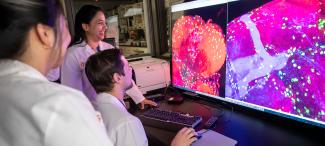Our Research
Our researchers conduct basic research with the goal of taking their research through the translational process and putting discoveries into practice. In many cases, research is disseminated into clinical studies on diseases, disorders and conditions to improve the health and wellness of a range of patient populations.
Mission
To grow a multidisciplinary and collaborative research infrastructure that leverages intellectual capital and enhances the success of our scientists in translating discoveries to promote the advancement of human health and reducing health disparities.
$442M
in total sponsored program award and research activity (FY24)
Top 3%
rank worldwide for all organizations that receive National Institutes of Health funding.
1200+
ongoing research studies that involve humans
Highlights

UT Health San Antonio earns top Carnegie classification for research, doctorate awards
The University of Texas Health Science Center at San Antonio earned a Research 1 (R1) designation from the American Council on Education and the Carnegie Foundation for the Advancement of Teaching in their 2025 Carnegie Classifications of Institutions of Higher Education. Of the 3,941 United States institutions evaluated, only 187 (4.7%) earned an R1 designation.

Global leaders in health: UT Health San Antonio is shaping the future of research and innovation
In Nature Index 2024, UT Health San Antonio ranked No. 32 out of 917 nationally for research output as a health care institute. The 2024-2025 U.S. News & World Report’s Best Global Universities rankings listed UT Health San Antonio as No. 51 among the world’s top 1,000 universities with clinical medicine research programs. UT Health San Antonio is in the top 5% worldwide, demonstrating its impact and reputation on a global academic stage.

CPRIT awards UT Health San Antonio $3.2 million to accelerate cancer research, launch novel clinical trial
The University of Texas Health Science Center at San Antonio (UT Health San Antonio) received more than $3.19 million in new academic research awards as part of the latest $68 million funding round announced on February 19 by the Cancer Research Prevention Institute of Texas (CPRIT). The state agency, which focuses on the fight against cancer, has now awarded $163.6 million to UT Health San Antonio since 2010.

UT Health San Antonio study uncovers key risk factors for diabetic foot infection recurrence
Texas has one of the highest rates of diabetes in the country, with more than 2.7 million Texans diagnosed with the condition. About one in six people in San Antonio have Type 2 diabetes, and a third of residents are prediabetic, according to the American Diabetes Association.



